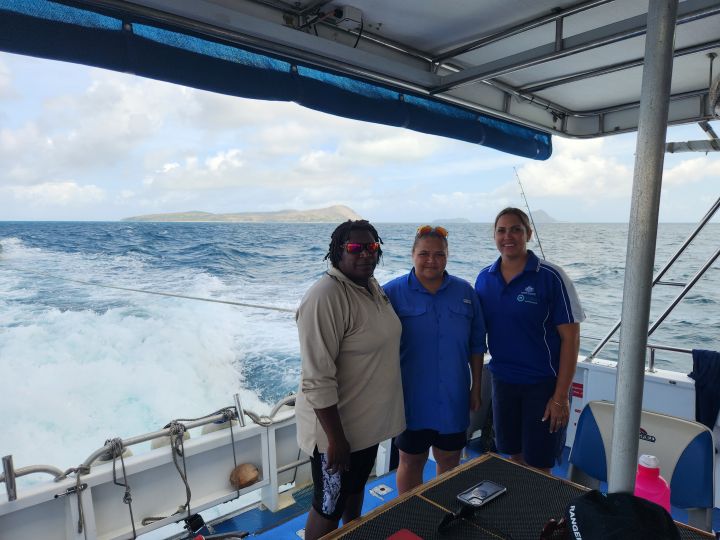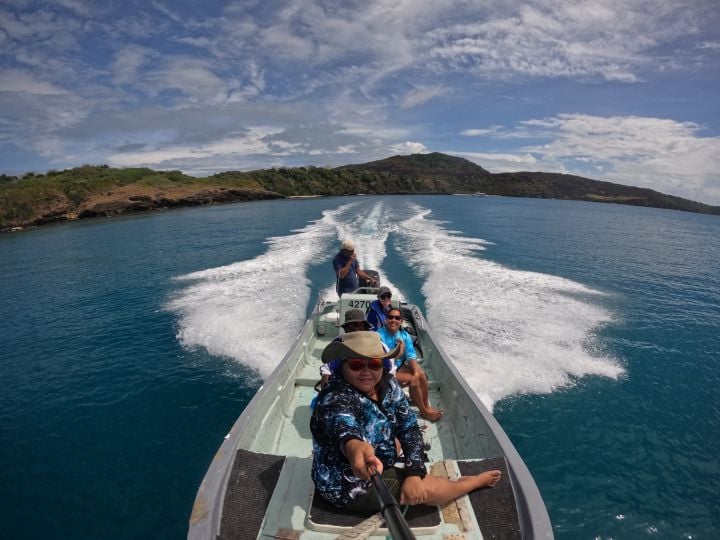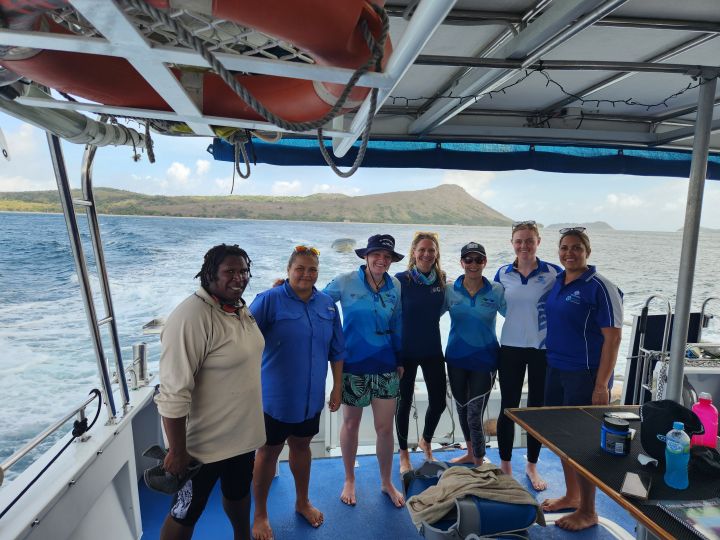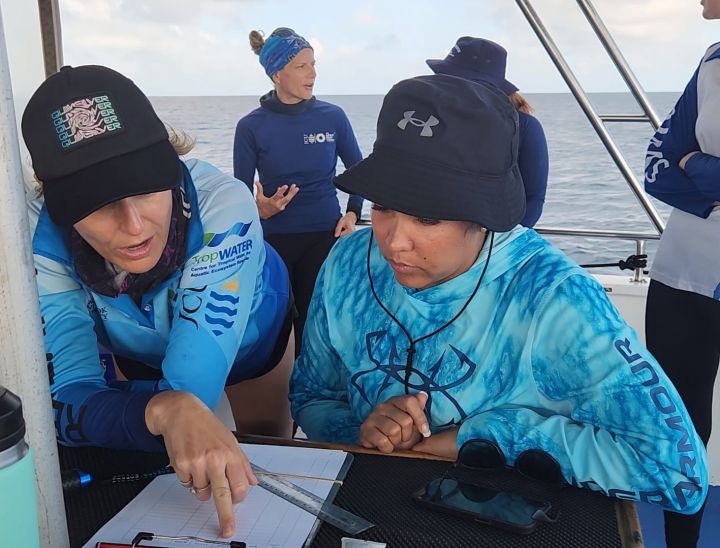
The Women Warriors of the Torres Strait– an all-female crew of Traditional Owners, rangers and scientists led by the Torres Strait Regional Authority (TSRA) Sea Team and James Cook University – set sail as part of the Great Reef Census to survey the northernmost section in the Torres Strait, northern Australia.
The voyage to Mer (Murray Island) in October by the Women Warriors of the Torres Strait is the first time the Great Reef Census – by Citizens of the Great Barrier Reef – has ventured beyond Cape York.
TSRA Senior Natural Resource Management Officer and Marine Biologist Madeina David, 24, said the trip served as ‘ethical science’ in the Torres Strait, with researchers and Traditional Owners working together to monitor the Great Barrier Reef, collect data and share findings with island communities to support local decision making.
“Our voyage sets a new course for science to value, respect and incorporate the traditional ecological knowledge of custodians who have cared for land and sea for centuries,” Ms David said.
“We will connect ancient knowledge and modern science to assess the condition of the northern Great Barrier Reef, including water temperatures, coral conditions and even explore the potential for a future turtle sanctuary.”
TSRA Sea Team Manager Moni Carlisle said checking conditions, including marine habitat at Mer, would provide critical insight into the future of the Great Barrier Reef.
“The Torres Strait is the northern tip of the Great Barrier Reef and known as the seagrass capital of the world. As home to globally important marine migratory species, including dugong and sea turtles, it is proving to be vital to the future of the Great Barrier Reef for both corals and sanctuary for species recovery,” she said.
JCU TropWATER’s Dr Katie Chartrand said the expedition was a valuable opportunity to work in partnership with Traditional Owners and rangers to paint a clearer picture of this hotspot of reef biodiversity.
“Using the Great Reef Census, we can rapidly collect thousands of reconnaissance images of remote reefs that have rarely or never before been formally surveyed,” she said.
Dr Chartrand said concerns have been raised of potential outbreaks of crown-of-thorns starfish, flagging the importance to survey this pristine region of the Great Barrier Reef.
“This Census gives TSRA and the local Meriam community a snapshot of the health of the reef habitats – and that’s a powerful strategy in taking steps to protect these extraordinary reefs.”
The Women Warriors of the Torres Strait Great Reef Census voyage is funded by the TSRA and supported by partners including the Citizens of the Great Barrier Reef and James Cook University.
Activities for the week at sea and on Mer saw the crew train Traditional Owners in cutting-edge technology including underwater video, drones, and mapping technology. In addition, local community sea mapping priorities led by Australian Institute of Marine Science (AIMS) with TSRA will seek to combine local knowledge with monitoring data from previous and current coral surveys. The work included a bit of fun with a community beach clean-up day led by the Tangaroa Blue Foundation with TSRA’s Mer Rangers and Sea Team on Friday 14 October.
Additional quotes:
Mer Traditional Owner and Native Title Body Corporate Chairperson Falen Passi:
“The island of Mer, its surrounding reefs and waters are special as the birthplace of Mabo and homeland of native title in Australia – connecting land and sea rights with culture, language and identity,” Mr Passi said.
“In Meriam culture we regard the sea as family, we name our oceans and value our historic and ongoing role in reef science.”
TSRA Chairperson Napau Pedro Stephen AM:
“The Great Barrier Reef is a living system which continues up to Mer (Murray Island) in the Torres Strait, it doesn’t just stop at an invisible line marking the marine park boundaries near Cairns,” Mr Stephen said.
“Both traditional knowledge and western science are needed to ensure the future of the Great Barrier Reef for our next generations.”
Citizens of the Great Barrier Reef CEO Andy Ridley:
“For the first time, an incredible team including Torres Strait Islander rangers are conducting the Great Reef Census where the Great Barrier Reef begins in the Far North. The expeditions will capture surveys in the Torres Strait on some of the most remote reefs in the Great Barrier Reef. These rangers are joining a massive community up and down the reef collecting tens of thousands of reconnaissance images that will be analysed by citizen scientists around the world next year.”
Fast facts
Torres Strait
- The Torres Strait is located in Far North Queensland, Australia between Cairns and Papua New Guinea.
- The Torres Strait is home to two of the world’s oldest continuing cultures – Torres Strait Islanders and Aboriginal peoples – who for many centuries have cared for Land and Sea Country.
- Ashmore and Boot reefs near Mer are among the world’s most ecologically and diverse reefs connected to the coral seas.
- Six of the seven marine turtle species are found in the Torres Strait, including the critically endangered Hawksbill and one of Australia’s top identified threatened species, the northern Green Sea Turtle.
Great Barrier Reef
- The Great Barrier Reef is the world’s biggest single structure made by living organisms and largest coral reef system with >3000 individual reefs.
- Detailed long-term monitoring of the GBR over the last 35 years provides a snapshot of coral condition over time but represents <5% of reefs.
- Citizen science-based programs like Great Reef Census are growing as a way to complement formal government monitoring programs to better manage the iconic ecosystem.
- The Great Barrier Reef is the Sea Country of more than 70 Traditional Owner groups whose connections to the marine environment date back more than 60,000 years.
- The Great Barrier Reef is comprised of coral reefs, seagrass, mangroves and inter-reefal sponge and algal bed habitats that build a complex and biodiverse ecosystem.
- As the impacts of climate change become more advanced, scientists and managers need up-to-date information on individual reefs to better target their resources and protections. The Great Reef Census is trialling new ways of using citizen science to help understand how the system is changing year-on-year.




